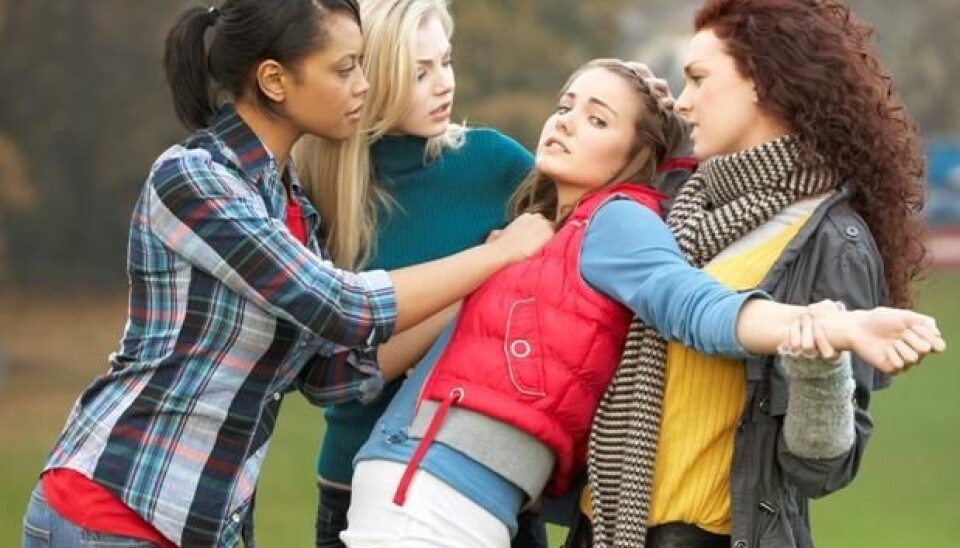
Girls use violence to gain respect
A pioneering study shows that some girls feel they gain respect by behaving aggressively and using violence.
Two girls are chatting to each other on a railway station platform as a third girl walks by. When she accidentally bumps into them, violence suddenly erupts. The third girl is kicked, slapped and thrown to the ground by the other two, who then run off.
It's not an uncommon sight. These days, the courts have to deal with a constant stream of cases involving aggression and violence by girls.
But why do they resort to this type of behaviour? To investigate the causes, a pioneering study is being conducted by Danish anthropologist Ann-Karina Henriksen. For six months she has monitored and interviewed 20 girls exhibiting violent behaviour, and her findings have revealed a clear picture of why some girls use violence.
"They talk about how violence can give them status. Many of them come from areas where you have to watch your back to avoid assaults, which can be anything from being hit or having things taken from you, to being called a slag or a loser," says Henriksen, who is conducting her studies at Roskilde University.
These girls are used to looking after themselves and their friends, and they protect themselves with violence. They say it’s all about honour and respect, and that they refuse to be trodden on.
Ann-Karina Henriksen
"These girls are used to looking after themselves and their friends, and they protect themselves with violence. They say it’s all about honour and respect, and that they refuse to be trodden on."
Degrees of violence
Henriksen has been monitoring girls in the Copenhagen area who are familiar with using violence of the following kinds:
- Humiliation. This action is agreed in advance between several girls, and involves such things as writing words like 'slag' over the victim's chest, burning her skin with cigarettes, urinating on her or forcing her to eat inedible materials.
- Reacting to minor provocations. If a girl is bumped into by another girl, she has to react by pushing back or kicking, or retaliating with smacks round the head. This kind of violence is of short duration.
- Outright brawling. The girls punch or kick each other, and afterwards cannot precisely remember what happened.
It is, however, rare to see the girls engage in one-on-one violent confrontations.
It's all about finding that knife-edge balance between gaining respect by using threats and violent body language, without going to extremes. Although these girls use violence, it is usually not something they are proud of.
Ann-Karina Henriksen
"In these environments, girls like to show that they can fight. But they mustn't lose control, which can easily occur in a one-on-one fight. That doesn't fit with their perceptions of what is okay," says Henriksen.
"It's all about finding that knife-edge balance between gaining respect by using threats and violent body language, without going to extremes. Although these girls use violence, it is usually not something they are proud of."
Status and self-defence
The girls give three reasons why they resort to violence
1. They get status from showing they're willing to use violence.
The girls look for the kind of company where they mean something.
"They say that previously they were quiet and unassertive, but after getting on the streets they've got attitude – they've become someone," says the researcher.
"It's an interesting question whether the girls learn to fight on the streets, or whether they learn to fight to be able to go on the streets. My hunch is the latter."
2. They need to defend themselves.
They need to react if someone has a go at them on the street, or looks at them in a bad way.
"If you don't react, you are accepting that you are nothing. If someone pisses on you, it gets around quickly if you didn't do anything about it,” she says.
3. They defend their friends, who are often the only friends they have.
"These girls live lives where they generally have difficulty in setting the agenda. Many do poorly at school, or have been expelled. And their social workers change all the time.”
When the parents or the system fails to help, the girls turn to each other for help. When they're kicked out of their homes late at night, they can ring one of their friends and find somewhere to sleep.
"Loyalty in relation to threats or humiliations correlates with loyalty in relation to a whole load of other problems. The girls want to be there for each other."
Social background is not the whole story
Social background is usually given as the reason why youths cannot come to terms with society. It is also used to explain how violence is associated with girls who have had a difficult upbringing, where domestic violence is common. But the researcher believes this explanation is too simple.
"Instead of looking at individuals and their upbringing, you can view these girls as human beings in defined circumstances. In conflict situations, tensions can rapidly escalate among those directly involved. When looked at in that way, the focus isn't the girl as an individual but the situations that escalate into violence."
A street logic that accepts violence
Besides social background, Henriksen thinks that research is needed into two other aspects in order to understand why girls resort to violence.
- The girls that she interviewed were all at the bottom of the social pile they found themselves in. Not surprisingly, they had little influence in life and so sought the kind of company where they felt empowered.
- There is a street mindset among youths that accepts certain forms of violence, and actually views it as necessary in certain situations. Henriksen is not occupied with the origins of this mindset, but is aware that the same logic can be found among men in motorcycle gangs, for example.
Seeds of hope
It is an uphill struggle for these violent girls, and a long way from the ideal of properly completing their education and moving forwards to a life where they have work, a husband, children and a home of their own.
But the researcher believes that the research contains seeds of hope. If it can be understood why girls adopt violent behaviour, it could provide the tools to help avoid situations that end in the violence which brands these girls as outsiders.
"In institutional settings, many conflicts develop between the girls and the social workers. Today it is the youngsters themselves who are regarded as the cause of the conflict. But it should rather be seen as a situation conflict where the youngsters, adults and the institutional setting all have a causal connection," she says.
"It would be enormously beneficial for both the girls and those employed to handle their cases if these conflicts could be viewed in a new light."
Henriksen's current studies are set to continue until spring 2013.
Translated by: Nigel Mander









